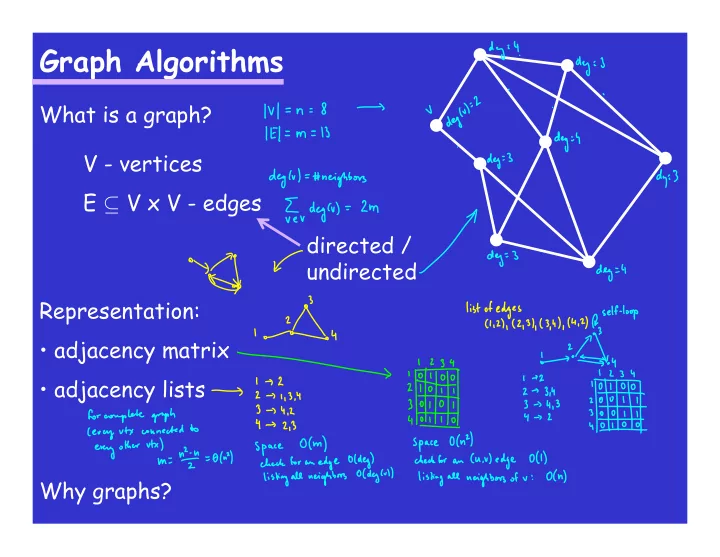

Graph Algorithms What is a graph? V - vertices E ⊆ V x V - edges directed / undirected Representation: • adjacency matrix • adjacency lists Why graphs?
Graph Algorithms Graph properties: • connected • cyclic • … Tree – a connected acyclic (undirected) graph
Graph Traversals Objective: list all vertices reachable from a given vertex s
Breadth-first search (BFS) Finds all vertices “reachable” from a starting vertex. Byproduct: computes distances from the starting vertex to every vertex BFS ( G=(V,E), s ) 1. seen[v]=false, dist[v]= ∞ for every vertex v 2. beg=1; end=2; Q[1]=s; seen[s]=true; dist[s]=0; 3. while (beg<end) do 4. head=Q[beg]; 5. for every u s.t. (head,u) is an edge and 6. not seen[u] do 7. Q[end]=u; dist[u]=dist[head]+1; 8. seen[u]=true; end++; 9. beg++;
Depth-first search (DFS) Finds all vertices “reachable” from a starting vertex, in a different order than BFS. DFS-RUN ( G=(V,E), s ) 1. seen[v]=false for every vertex v 2. DFS(s) DFS(v) 1. seen[v]=true 2. for every neighbor u of v 3. if not seen[u] then DFS(u)
Applications of DFS: topological sort Def: A topological sort of a directed graph is an order of vertices such that every edge goes from “left to right.”
Applications of DFS: topological sort Def: A topological sort of a directed graph is an order of vertices such that every edge goes from “left to right.”
Applications of DFS: topological sort Def: A topological sort of a directed graph is an order of vertices such that every edge goes from “left to right.”
Applications of DFS: topological sort Def: A topological sort of a directed graph is an order of vertices such that every edge goes from “left to right.”
Applications of DFS: topological sort TopSort ( G=(V,E) ) 1. for every vertex v 2. seen[v]=false fin[v]= ∞ 3. 4. time=0 5. for every vertex s 6. if not seen[s] then 7. DFS(s) DFS(v) 1. seen[v]=true 2. for every neighbor u of v 3. if not seen[u] then 4. DFS(u) 5. time++ 6. fin[v]=time (and output v)
Applications of DFS: topological sort TopSort ( G=(V,E) ) 1. for every vertex v 2. seen[v]=false fin[v]= ∞ 3. 4. time=0 5. for every vertex s 6. if not seen[s] then 7. DFS(s) DFS(v) 1. seen[v]=true 2. for every neighbor u of v What if the graph 3. if not seen[u] then contains a cycle? 4. DFS(u) 5. time++ 6. fin[v]=time (and output v)
Appl.DFS: strongly connected components Vertices u,v are in the same strongly connected component if there is a (directed) path from u to v and from v to u.
Appl.DFS: strongly connected components Vertices u,v are in the same strongly connected component if there is a (directed) path from u to v and from v to u. How to find strongly connected components ?
Appl.DFS: strongly connected components STRONGLY-CONNECTED COMPONENTS ( G=(V,E) ) 1. for every vertex v 2. seen[v]=false 3. fin[v]=1 4. time=0 5. for every vertex s 6. if not seen[s] then 7. DFS(G,s) (the finished-time version) 8. compute G^T by reversing all arcs of G 9. sort vertices by decreasing finished time 10. seen[v]=false for every vertex v 11. for every vertex v do 12. if not seen[v] then 13. output vertices seen by DFS(v)
Appl.DFS: strongly connected components STRONGLY-CONNECTED COMPONENTS ( G=(V,E) ) 1. for every vertex v 2. seen[v]=false 3. fin[v]=1 4. time=0 5. for every vertex s 6. if not seen[s] then 7. DFS(G,s) (the finished-time version) 8. compute G^T by reversing all arcs of G 9. sort vertices by decreasing finished time 10. seen[v]=false for every vertex v 11. for every vertex v do 12. if not seen[v] then 13. output vertices seen by DFS(v)
Many other applications of D/BFS DFS • find articulation points • find bridges BFS • e.g. sokoban
Many other applications of D/BFS BFS • e.g. sokoban
Recommend
More recommend